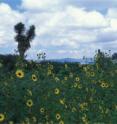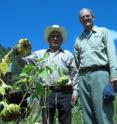Ancient sunflower fuels debate about agriculture in the Americas
Ancient Sunflower Fuels Debate About Agriculture in the Americas Researchers at the University of Cincinnati and Florida State University have confirmed evidence of domesticated sunflower in Mexico — 4,000 years before what had been previously believed. “People sometimes ask “What is the big deal about sunflower"” says David Lentz, professor of biological sciences and executive director of the Center for Field Studies in the McMicken College of Arts & Sciences at the University of Cincinnati (UC). Lentz worked with Mary Pohl from Florida State University, José Luis Alvarado from Mexico’s Institute of Anthropology and History, and Robert Bye from the Independent National University of Mexico.
“First of all, sunflower is one of the world's major oil seed crops and understanding its ancestry is important for modern crop-breeding purposes," Lentz says. "For a long time, we thought that sunflower was domesticated only in eastern North America, in the middle Mississippi valley — Arkansas, Missouri, Tennessee, Illinois. This is what traditional textbooks say. Now it appears that sunflower was domesticated independently in Mexico."
"The Mexican sunflower discovery suggests that there may have been some cultural exchange between eastern North America and Mesoamerica at a very early time,” Lentz adds. “Now the textbooks need to be rewritten.”
More than just a matter of pride over which part of America can claim a flower, the debate centers on when sunflower was domesticated and which civilization first cultivated it. Now there is solid evidence that two similar events took place thousands of years and hundreds of miles apart.
Lentz and his fellow researchers have documented archaeological, linguistic, ethnographic and ethnohistoric data demonstrating that the sunflower had entered the repertoire of Mexican domesticates by 2600 B.C., that its cultivation was widespread in Mexico and extended as far south as El Salvador by the first millennium B.C., that it was well known to the Aztecs, and that it is still in use by traditional Mesoamerican cultures today. (People of the Americas made huge contributions to today’s society in terms of agriculture, including the development of a number of valuable crops such as corn, peppers, beans, cotton, squash, chocolate, tomatoes and avocadoes, as well as sunflower.)
But it is unknown if the Mexican domestication and North American domestication are related. So is it coincidence" Did one cause the other" Or did they both happen because of some other common outside factor"
“Whatever conclusions we draw, the evidence clearly shows that sunflower as a Mexican crop goes back far into antiquity,” says Lentz.
In addition to the biogeographic study of sunflower, the researchers conducted archaeological, linguistic, ethnographic and ethnohistorical research, collecting data from many fields of study.
Archaeological evidence of sunflower in Mexico has been rare, probably for a number of reasons. First, the way it was used may not have been conducive to deposition in archaeological sites. Second, climatic conditions, especially in the Neotropics, have bad properties of preservation for plant parts so most things just rot away. Finally, archaeological research strategies in many areas of Mesoamerica focus more on monumental architecture and less on agricultural developments. That is, you are unlikely to find something if you are not looking for it.
Nevertheless, sunflower achenes (this is what most of us call the seed, but it is actually the fruit of the sunflower, containing the seed) were found in Mexico in situations where the preservation was especially good. Cueva del Gallo was a dry cave and the sunflower achenes there were in pristine condition. San Andrés was a waterlogged site and the sunflower remains from that site were also well preserved. Using accelerator mass spectrometry, the sunflowers at San Andrés were found to be older than 2600 B.C.
The researchers also asked indigenous people in Mexico what terms they used for the sunflower.
“They described how they used sunflower and told us the name in their native language,” says Lentz. “The names they used for sunflower were all unique, not related to Spanish. That tells us the use of sunflower is older than the Spanish expeditions of the 15th and 16th centuries."
The Otomi, one of the Mexican indigenous groups interviewed, use the name “dä nukhä,” which translates to “big flower that looks at the sun god,” a reference to pre-Columbian solar worship. The sunflower is commonly still used as an ornament in their churches.
“When asked about sunflowers, people of the Nahua culture in Mexico, descendants of the Aztecs gave us a clue to help interpret early historic texts,” describes Lentz. “The modern Nahua use two words for sunflower: ‘chimalxochitl,’ which means ‘shield flower,’ or ‘chimalacatl,’ which means ‘shield reed,’ which is also a reference to its hollow stem and large, disk-like head (that resembles an Aztec shield). These terms led us to sunflower references to listed in early chronicles of 16th century Aztec society, including ‘The Florentine Codex,’ written by Fray Bernardino de Sahagun. In the Florentine Codex, the sunflower is described as part of an offering to the Sun God, 'Huitzilopochtli.'"
The researchers point out, the sunflower’s association with solar worship and warfare in Mexico may have led to its suppression after the Spanish Conquest.
“Sunflower was believed to be a powerful aphrodisiac, which could have also contributed to its being banned by the Spanish priests,” Lentz says with a smile. “Of course, it is not but this belief was probably part of the case against sunflowers.”
“Mesoamerica had a thriving culture, a grand civilization,” Lentz notes. “They had irrigation systems, monumental construction, agriculture and a complex society.
This is a Native American of the Otomi group who was interviewed by the researchers about her sunflower knowledge.
The group's research is published in the Proceedings of the National Academy of Science (PNAS) as “Sunflower (Helianthus annuus L.) as a Pre-Columbian Domesticate in Mexico” with UC’s David Lentz as lead author and co-authors Mary Pohl from Florida State, José Luis Alvarado from Mexico’s Institute of Anthropology and History and Robert Bye from the Independent National University of Mexico. (Lentz’s student, Somayeh Tarighat, is also a co-author on the paper.)
“The discovery of ancient sunflower in Mexico refines our knowledge of domesticated Mesoamerican plants and adds complexity to our understanding of cultural evolution,” the authors state in the paper.
Lentz’s research on the biogeography of sunflower is also being published at the same time as the cover story for the International Journal of Plant Sciences, “Ecological Niche Modeling and Distribution of Wild Sunflower (Helianthus annuus L.) in Mexico,” with co-authors Robert Bye and Victor Sánchez-Cordero from the Independent National University of Mexico (UNAM).
“Beyond the recognition of the great cultures due these early peoples, there are very real lessons that we can learn from them. As we deal with our modern-day issues of global warming and as we evaluate and examine what crops will survive and thrive in warmer climates, the ancient Aztecs might have some valuable lessons to teach us — and the descendants of the Aztecs may have valuable sunflower seed stocks to help improve our modern agricultural capability.”
Source: University of Cincinnati
Articles on the same topic
- Sunflower debate ends in Mexico, researchers sayWed, 30 Apr 2008, 18:58:31 UTC
Other sources
- Made in Mexico: domesticated sunflowersfrom LA Times - ScienceFri, 2 May 2008, 18:35:05 UTC
- Ancient Sunflower Fuels Debate About Agriculture In The Americasfrom Science DailyWed, 30 Apr 2008, 18:55:48 UTC
- Ancient sunflower fuels debate about agriculture in the Americasfrom Biology News NetWed, 30 Apr 2008, 18:48:29 UTC


